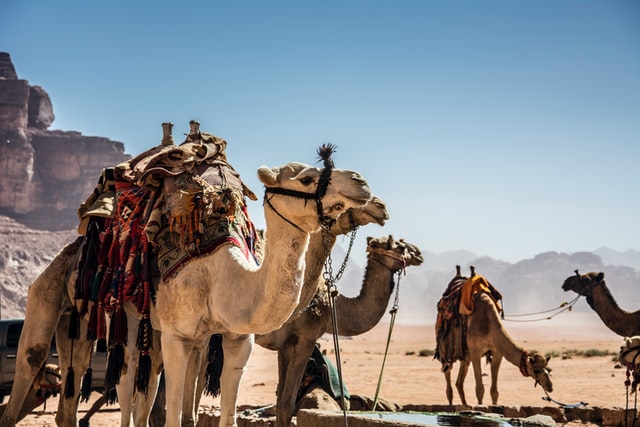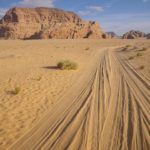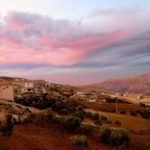Dinner in the Desert: A Bedouin Zarb in the Wadi Rum, Jordan

As a native from the region of clambakes, I should not have been surprised that my dinner for the evening was cooking underneath the hot desert sand. But in my defense, the Wadi Rum was an astonishing place and never where I imagined I’d be eating dinner one day. Yet there I was, in one of Jordan’s UNESCO World Heritage Sites that boasts sprawling sands, towering cliffs, and archaeological remains that affirm 12,000 years of human settlement. I was about to partake in my first zarb.
Zarb, similar to a barbeque or a roast, is a form of cooking from Bedouin culture in the Arabian Peninsula that utilizes an “earth oven” to cook large quantities of meat and vegetables. An ancient universal concept of cooking, groups across the world have adapted the earth oven to their natural environments and climate to create needed (and often delicious) sustenance, either as rúgbrauð in Iceland, hangi in New Zealand, or zarb in Jordan.
The method is popular in part due to its lack of equipment, fitting the nomadic lifestyle of the Bedouins.
You don’t realize how scentless the desert is until the sand has been brushed away from the top of the oven, the lid removed, and the rack of food rises from the earth.
Traditionally, for a zarb, a very large hole was dug with a rounded wall to keep any sand from falling into the food. Next, a fire was lit in the hole and left to burn until only embers of coal remained. Meat such as chicken, goat, or lamb, and a wide assortment of vegetables were cut and seasoned then wrapped in palm leaves and placed on top of the coals.
The hole was then covered with a large round stone and some branches (to keep the sand out) until enough time had passed for everything to be thoroughly cooked.
Preparing a zarb hasn’t greatly changed over time. Details of the process have been finessed, but it mostly remains the same. The large hole in the sand is still essential. However nowadays, a metal oven casing is fitted in the hole before any food or coal, which is placed at the bottom of the casing.
Food is wrapped in foil rather than palm leaves and placed on a multi-level rack that is lowered into the case. Meat is on the lower levels and vegetables are on top to ensure even cooking. The oven is finally sealed with a lid then covered with a blanket. Between 1.5 and 2.5 hours later comes the grand reveal.
This is a place for communal eating, where you must cozy up next to your neighbor, knock elbows, and share what table space you can to enjoy the copious amounts of food piled on your plate.
You don’t realize how scentless the desert is until the sand has been brushed away from the top of the oven, the lid removed, and the rack of food rises from the earth. The tangy, savory scent of meat fills the air, the delicate balance of spices just tingling your nostrils. Little wisps of steam escape the foil and float in the arid air as the rack is carried into the dining tent.
The dining tent in Wadi Rum is a cozy, colorful mess hall. Bright rugs and tapestries cover the walls and ceiling. Built-in benches, padded with heavy woven fabrics in reds, oranges, browns, and black, line the perimeter of the walls. Long low wooden benches and chairs fill up the space in between the walls.
Dinner in the Desert: A Bedouin Zarb in the Wadi Rum, Jordan.
There is the buffet line in one back corner and a bar opposite, selling cold sodas, coffee, water, and snacks. This is a place for communal eating, where you must cozy up next to your neighbor, knock elbows, and share what table space you can to enjoy the copious amounts of food piled on your plate.
During my first zarb, chicken was the meat of the day. The skin was crisp and the meat had a smoky flavor. The chicken was surprisingly not dry at all, as something made in the desert might be. Our desert-roasted carbs and vegetables for the evening included small potatoes baked to a delicate soft state, and aromatic onions and peppers. Then, there were the side dishes: rice, hummus, mutabal, and salad. This dinner in the desert was an astounding feat filled with flavors to satisfy every palate.
However, if there is one star in this culinary masterpiece of dining in Wadi Rum, it is a beverage: Bedouin tea. This sweet blend is perfect refreshing, even in the heat. There is no one set recipe for this drink, which is as common across the Arabian Peninsula as it is varied.
Traditionally, it includes dried wild sage leaves and large amounts of raw sugar. Ingredients such as thyme, cardamom, cinnamon, and black tea leaves may be added.
Traditionally, it includes dried wild sage leaves and large amounts of raw sugar. Ingredients such as thyme, cardamom, cinnamon, and black tea leaves may be added. Brewed together over a fire and served piping hot, I still could not help but gulp down the sugary nectar. A zarb is simply incomplete without at least one cup of tea.
Stomach filled and tastebuds satisfied, I took a few minutes to reflect. I never thought I’d end up eating dinner in the desert, and I definitely never imagined it’d be so delicious. Then, I got up for another cup of tea.
Dinner in the Desert: A Bedouin Zarb in the Wadi Rum, Jordan photo credit by Unsplash.









Wow, I thought this was only done in Iceland! Good to know!